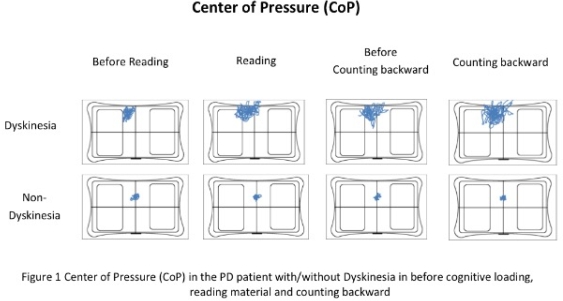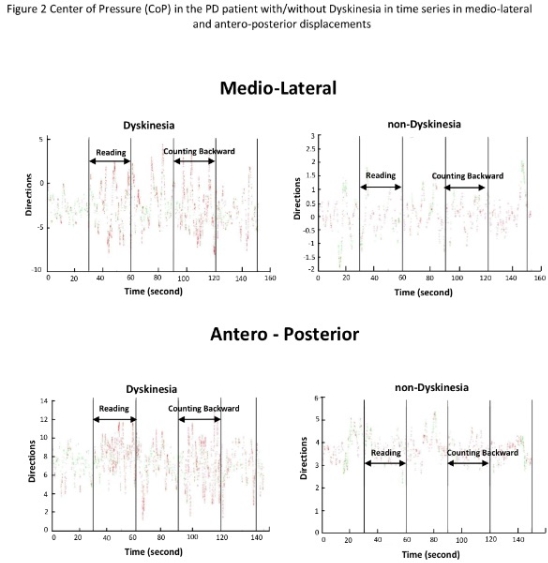Session Information
Date: Tuesday, June 21, 2016
Session Title: Technology
Session Time: 12:30pm-2:00pm
Location: Exhibit Hall located in Hall B, Level 2
Objective: To propose a strategy to classify Parkinson’s disease (PD) with/without dyskinesia by analyzing center of pressure (CoP) with impact of cognitive loading.
Background: Cognitive impairments have been commonly found in Parkinson’s disease (PD). Recently, cognitive impairments, dyskinesia and postural instability (PI) have been assessed separately. All of the factors have been rarely evaluated to express the relationships of each part; however, the studies as regards postural instability in terms of the analysis of center of pressure (CoP) illustrate the abnormality of controlling body posture. Dyskinesia is presented according to the side effects of medication, which can be seen accompany by balance disturbances. How can we acknowledge the relationships between cognitive impairments, dyskinesia and PI in PD? A strategy to classify PD patient with/without dyskinesia has been proposed from this study.
Methods: Posturographic recordings with cognitive loading were obtained from 30 PD patients with/without dyskinesia by the balance platform (Nintendo Wii Fit). The patients were instructed to perform 2 tasks; reading material and counting backward in 170 seconds in total. The analysis of center of pressure (CoP) was determined to classify PD patients with/without dyskinesia in the posturographic parameters; path length (PL), sway area (SA), root mean square (RMS), mediolateral (ML) and anteroposterior (AP). General demographic data, Hoehn and Yahr scales (H&Y), UPDRS motor score, levodopa equivalent dose (LED), presence of dyskinesia, and the Montreal cognitive assessment (MoCA) were included. The data analysis was calculated by MATLAB with written program and SPSS.
Results: Significant increases of PL, SA, RMS, ML and AP were found during cognitive loading; reading material and counting backward, in PD patients with dyskinesia.
| PD (N=30) | ||||
| CoP | Before Reading | Reading | Before Counting backward | Counting backward |
| PL | 91.81±49.65 | 113.25±82.82** | 102.46±62.77 | 129.3±105.91** |
| SA | 11.27±12.6 | 16.95±25.73 | 18.19±26.98 | 27.35±45.51 |
| RMS | 2.99±3.19 | 4.43±5.89 | 4.33±5.78 | 7.35±13.78 |
| ML | 2.84±1.96 | 3.43±3.18 | 3.44±2.79 | 4.13±3.82 |
| AP | 3.27±1.23 | 3.44±1.76 | 3.63±1.97 | 3.83±2.43 |
| Dyskinesia (N=7) | Non – Dyskinesia (N=23) | ||||||
| Before Reading | Reading | Before Counting backward | Counting backward | Before Reading | Reading | Before Counting backward | Counting backward |
| 149.8±105 | 201.2±135.1 | 74.97±15.72 | 245.7±158.56* | 74.97±15.72 | 86.49±29.31* | 171.9±99.46 | 93.87±48.02* |
| 28.08±13.18 | 45.13±39.61 | 6.94±6.1 | 67.88±59.34 | 6.94±6.1 | 8.38±10.73 | 44.5±38.86 | 15.01±3.3 |
| 6.98±3.14 | 10.66±8.82 | 1.42±0.9 | 15.22±11.39* | 1.42±0.9 | 2.53±2.89* | 8.74±7.68 | 4.95±13.76 |
| 5.15±1.97 | 7.07±4.6* | 2.1±1.29 | 7.21±3.36 | 2.1±1.29 | 2.33±1.44* | 6.58±3.16 | 3.19±3.5 |
| 5.15±1.33 | 5.22±2.47* | 2.63±0.81 | 6.52±2.83 | 2.63±0.81 | 2.91±1.06** | 5.59±2.62 | 3.01±1.61 |

Conclusions: Cognitive loading influences on the ability of postural control in PD patients with/without Dyskinesia. The fluctuated CoP from this technique can be considered to be an indicator to classify the patients. 
To cite this abstract in AMA style:
W. Buated, P. Lolekha, T. Fujinami, S. Hidaka. A strategy to classify Parkinson’s disease patients with dyskinesia: The analysis of center of pressure with impact of cognitive loading [abstract]. Mov Disord. 2016; 31 (suppl 2). https://www.mdsabstracts.org/abstract/a-strategy-to-classify-parkinsons-disease-patients-with-dyskinesia-the-analysis-of-center-of-pressure-with-impact-of-cognitive-loading/. Accessed April 25, 2025.« Back to 2016 International Congress
MDS Abstracts - https://www.mdsabstracts.org/abstract/a-strategy-to-classify-parkinsons-disease-patients-with-dyskinesia-the-analysis-of-center-of-pressure-with-impact-of-cognitive-loading/
